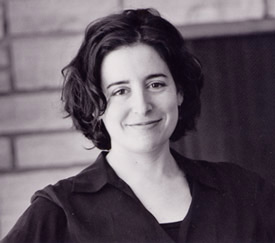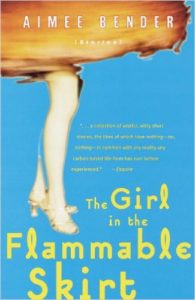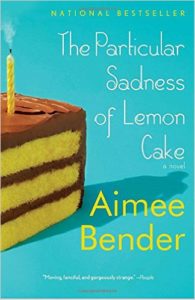Every month, I interview an author I admire on her literary firsts.
 December’s featured author is Aimee Bender, author of five books including The Girl in the Flammable Skirt, a short story collection stories unafraid to meld the real with the impossible, the grotesque with the funny, the sacred with the profane.
December’s featured author is Aimee Bender, author of five books including The Girl in the Flammable Skirt, a short story collection stories unafraid to meld the real with the impossible, the grotesque with the funny, the sacred with the profane.
Aimee’s other books are An Invisible Sign of My Own, Willful Creatures, The Particular Sadness of Lemon Cake, and The Color Master. She teaches creative writing at University of Southern California, my grad school alma mater.
In this interview Aimee talks about writing without a plan, giving writerly advice, and eating cake on book tour.
Sign up with your email below to be entered to win a copy of The Girl in the Flammable Skirt — and to get notified of future interviews!
____
 Siel: At a writing conference speech five or so years back, I remember you saying you’d decided to shelve a novel a few hundred pages long because it simply wasn’t working. For those of us who have also shelved writing projects — and may shelve more in the future — Do you have any tips or rituals or practices for setting a work aside and moving on to something new? I guess I’m asking about ways writers can come to some sense of closure for works that won’t go out into the larger world —
Siel: At a writing conference speech five or so years back, I remember you saying you’d decided to shelve a novel a few hundred pages long because it simply wasn’t working. For those of us who have also shelved writing projects — and may shelve more in the future — Do you have any tips or rituals or practices for setting a work aside and moving on to something new? I guess I’m asking about ways writers can come to some sense of closure for works that won’t go out into the larger world —
Aimee: What’s kind of reassuring is that the next novel I wrote ended up using a lot of that material— not directly, but in new ways. The work is like matter, it cannot be wasted. It just pushes you forward to the next thing. So, just write what you feel like writing. We are not so linear— the work resurfaces and resurfaces and so the drawer is really only a waystation.
How do you move between working on short stories and novels? Do you write both simultaneously, or work more on a project basis?
Simultaneously! I’m all about jumping around. Why not?
You’ve said in the past you tend to write without a plan. I’m envious and in admiration of this ability of yours — and also find that free-and-loose sounding writing process difficult to wrap my head around, because my own writing tends not to “go anywhere” without a plan. Is there any point in your writing process where you do sit down specifically to outline a story arc or create deliberate structure — or does all of that happen automatically for you in the process of writing the draft?
Thanks— it’s kind of painful as it happens but it also is the only way that works for me. It means A LOT of stuff never gets used. A lot of wandering. If you return to those pages that ‘go nowhere’ and you reread them, I would bet some cash that there are inroads to other parts in there that need slowing down and development and would begin to nudge you toward story. Jay Gummerman said it such a great way; “There is structure in nature”— meaning, there is structure inherent in your mind if you give it the room to explore. I really believe it.
 As a professor at USC, what pieces of advice do you find yourself give most frequently to students? Do you adhere to them yourself?
As a professor at USC, what pieces of advice do you find yourself give most frequently to students? Do you adhere to them yourself?
Play around. Try stuff out. Don’t think too much. I very much try to do these things myself but I also believe we teach what we most need to hear and rehear.
Since my own forthcoming book is cakey, I have to ask: How much lemon cake did you eat during the launch of The Particular Sadness of Lemon Cake?
Cakey! Great. I ate a lot. And, I heard a lot about how you’re actually not supposed to put chocolate with lemon. Who knew? Not me. It tastes good to me.
___
Purchase a copy of The Girl in the Flammable Skirt now, or enter to win one by signing up for the newsletter. Already joined up? Then you’re already entered!
